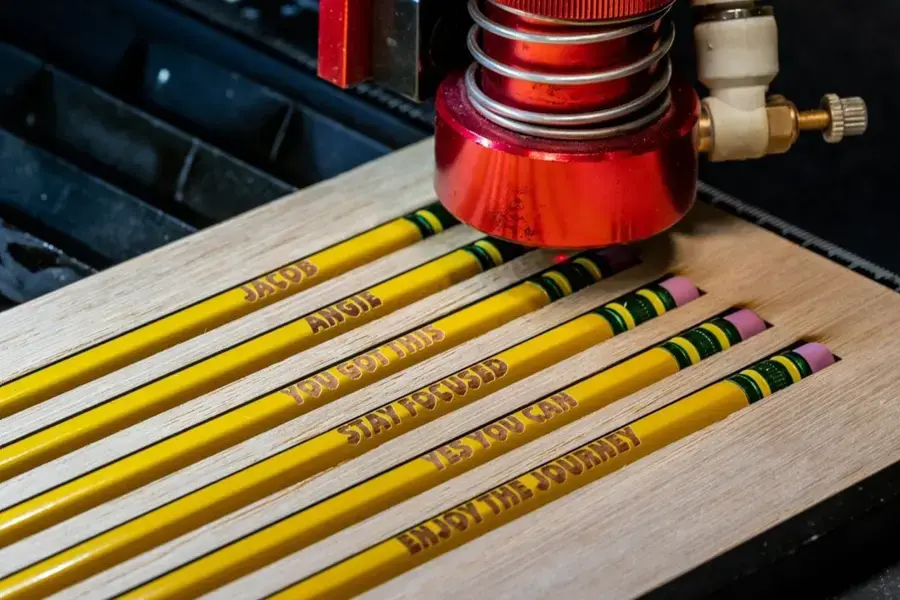
Engravable Materials: Dos & Don’ts
Laser engraving is the process of permanently marking a variety of surfaces with fine details using focused lasers. This process is used across multiple industries for customization, identification, and decorative purposes. Our Boss Laser machines are designed to work with various materials, guaranteeing consistently excellent results.
Knowing which materials work best for laser engraving is the secret to achieving the best results. The type of material you choose will impact both the process’s safety and engraving quality. Using the right materials ensures clean and precise markings, prevents hazardous gasses from escaping, and protects your machine from damage. For example, plastics like ABS and acrylic are popular because they offer versatility and a clean finish for various applications.
Engravable Materials: Dos & Don’ts
On the other hand, some materials should be avoided due to the risks they pose. Materials like PVC and vinyl contain chlorine and can produce harmful gasses that jeopardize safety and equipment integrity.
HERE’S A GUIDE TO HELP YOU NAVIGATE THE DOS AND DON’TS OF ENGRAVABLE MATERIALS:
Plastics
- ABS (Acrylonitrile Butadiene Styrene)
- Acrylic (Als known as Plexiglas, Lucite, PMMA)
- Delrin (POM, Acetal)
- High Density Polyethylene (HDPE)- Melts Badly
- Kapton Tape (Polyimide)
- Mylar (Polyester)
- Nylon – Melts Badly
- Polyethylene Terephthalate Glycol (PETG)
- Polyethylene – Melts Badly
- Polypropylene – Melts somewhat
- Styrene
- Two-Toned Acrylic – two-layer colored acrylic, top layer is a different color than the base color. Used for signs, plaques, and instrumentation panels.
Foam
- Depron – Often used for RC planes
- Ethylene Vinyl Acetate (EVA)
- Gator Foam – Hard shell of gator foam does well but the foam core gets burned and eaten away.
Textiles and Others:
- Cloth- Leathers, suede, felt, hemp, cotton
- Paper – Cardstock, cardboard.
- Rubber – These can only be used if they do not contain chlorine Teflon (PTFE, Polytetrafluoroethylene)
- Woods – MDF, balsam, birch, poplar, red oak, cherry, holly, etc.
Materials that can’t/should not be cut with a laser.
- Metals (exceptions of etching = Using TherMark. Cutting = HP models “Oxygen/Air assist”
- Polycarbonate (PC, Lexan) due to the fumes.
- Any material containing chlorine
HP (High Pressure) materials include all the above guidelines and as listed:
- Stainless steel up to 18 gauge
- Mild steel up to 20 gauge
- Thicker and denser woods
Precision Engraving with Boss Laser
Engraving on one material might come out a little differently than engraving on another. We recently used leather material to complete a project for Harley Davidson due to leather being the best material for it.
Using the Boss LS-2436 with a 100-watt glass tube, we showcased how effortlessly this machine cuts and engraves leather. The process highlighted the machine’s precision and power, making it ideal for crafting custom leather goods. This video tutorial demonstrates our process, which is perfect for creating personalized items like wallets, belts, and notebook covers.
How You Can Get Started
Selecting the right materials and understanding the dos and don’ts of laser engraving can significantly improve the quality and longevity of your projects. Our Boss Laser machines are adaptable and can work with a variety of materials.
Contact Boss Laser today to learn more about our products and how we can meet your needs. Whether you’re a business looking to enhance your branding or a hobbyist exploring new creative possibilities, we’re here to help you get started. Experience the Boss Laser difference—where unmatched customer service and precision meet greatness.